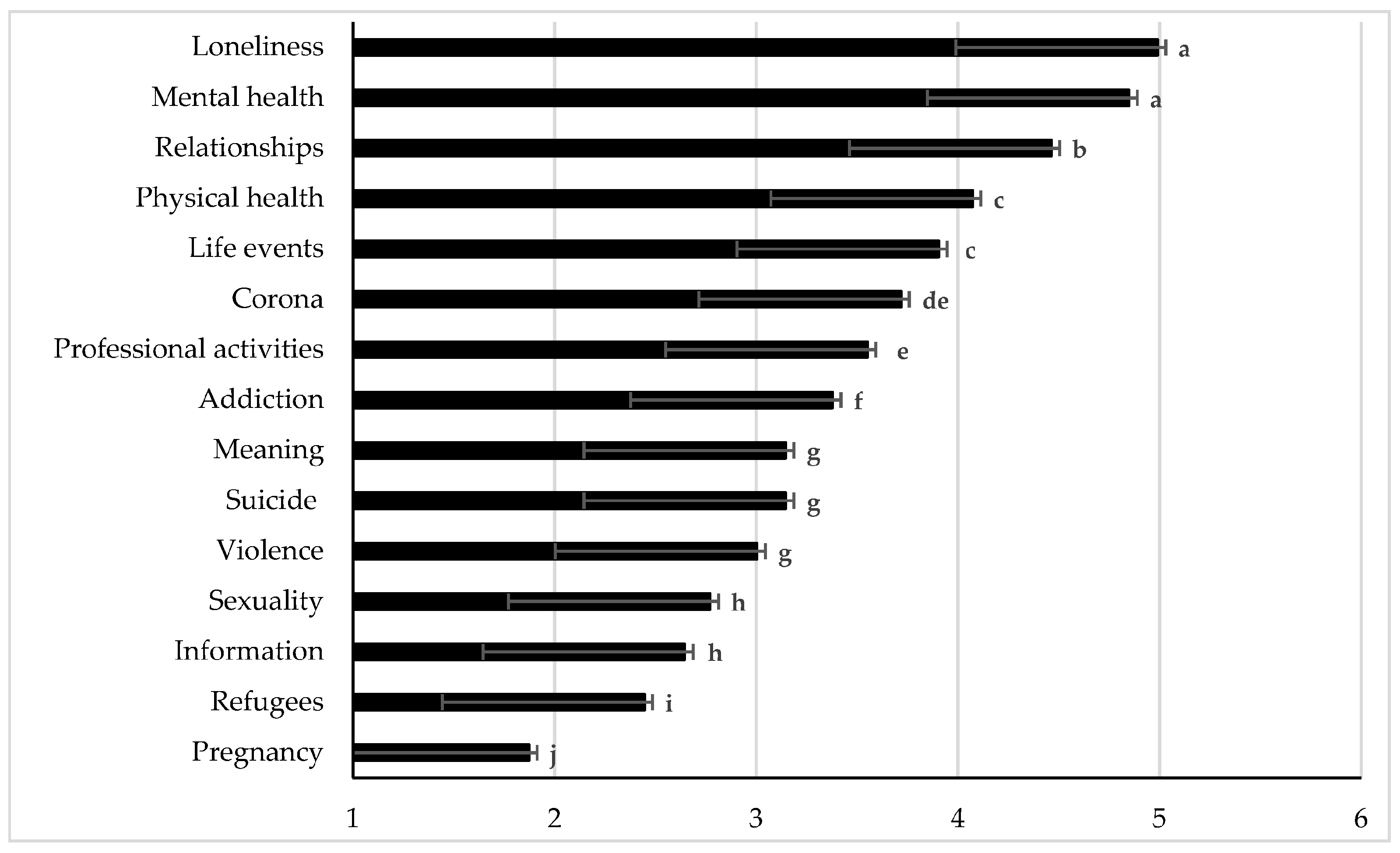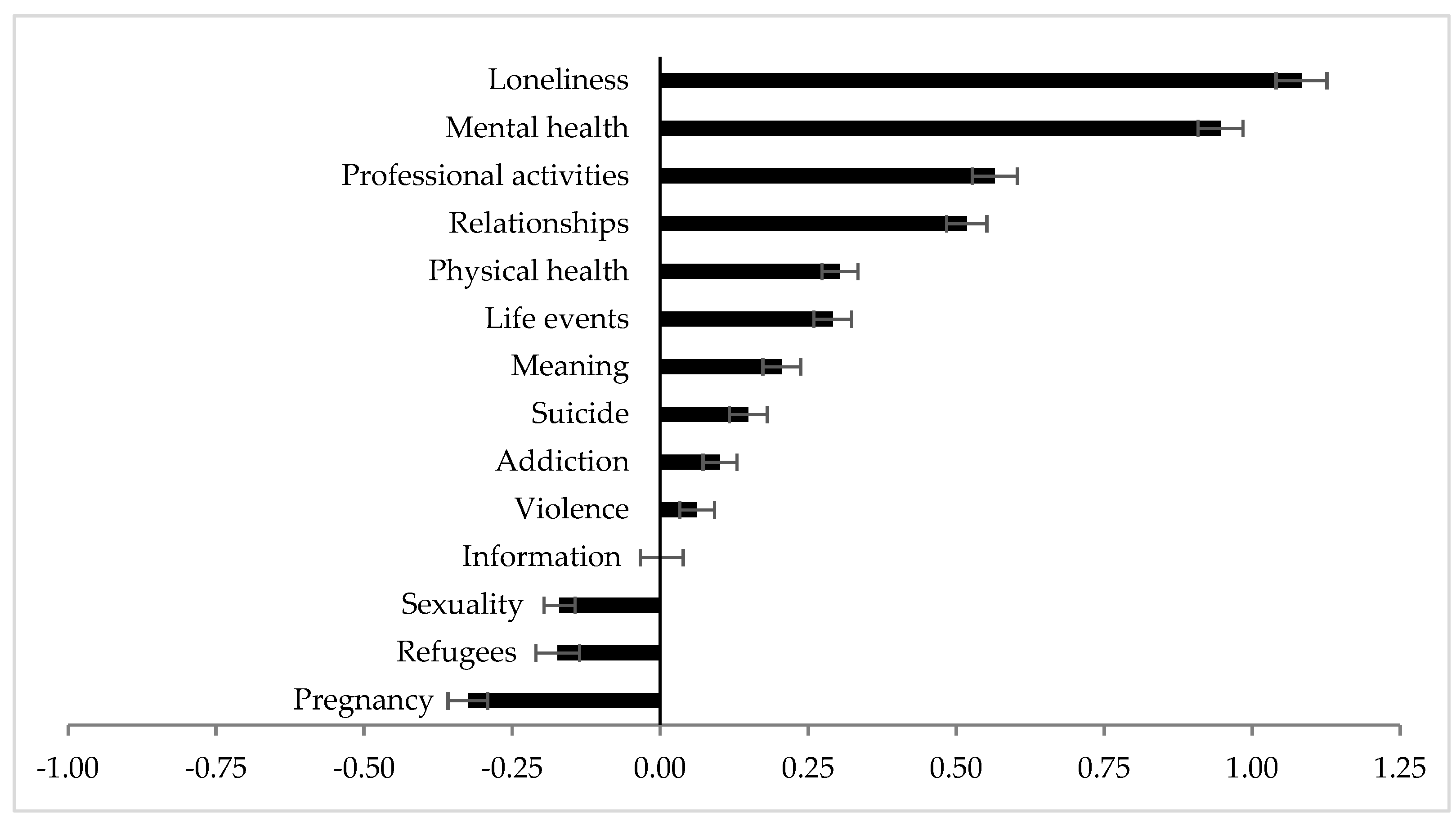Telephone Emergency Service 142 (TelefonSeelsorge) during the COVID-19 Pandemic: Cross-Sectional Survey among Counselors in Austria
Abstract
1. Introduction
2. Materials and Methods
2.1. Study Design
2.2. Measures
2.3. Statistics
3. Results
3.1. Participants
3.2. Results for RQ1
3.3. Results for RQ2
3.4. Results for RQ3
4. Discussion
5. Conclusions
Author Contributions
Funding
Institutional Review Board Statement
Informed Consent Statement
Data Availability Statement
Acknowledgments
Conflicts of Interest
References
- Hasson-Ohayon, I.; Lysaker, P.H. Special challenges in psychotherapy continuation and adaption for persons with schizophrenia in the age of coronavirus (COVID-19). Couns. Psychol. Q. 2020, 1–9. [Google Scholar] [CrossRef]
- Humer, E.; Schimböck, W.; Kisler, I.M.; Schadenhofer, P.; Pieh, C.; Probst, T. How the covid-19 pandemic changes the subjective perception of meaning related to different areas of life in austrian psychotherapists and patients. Int. J. Environ. Res. Public Health 2020, 17, 8600. [Google Scholar] [CrossRef] [PubMed]
- Salari, N.; Hosseinian-Far, A.; Jalali, R.; Vaisi-Raygani, A.; Rasoulpoor, S.; Mohammadi, M.; Rasoulpoor, S.; Khaledi-Paveh, B. Prevalence of stress, anxiety, depression among the general population during the COVID-19 pandemic: A systematic review and meta-analysis. Global. Health 2020, 16, 57. [Google Scholar] [CrossRef]
- Serafini, G.; Parmigiani, B.; Amerio, A.; Aguglia, A.; Sher, L.; Amore, M. The psychological impact of COVID-19 on the mental health in the general population. QJM Int. J. Med. 2020, 113, 531–537. [Google Scholar] [CrossRef]
- Pieh, C.; Budimir, S.; Probst, T. The effect of age, gender, income, work, and physical activity on mental health during coronavirus disease (COVID-19) lockdown in Austria. J. Psychosom. Res. 2020, 136, 110186. [Google Scholar] [CrossRef]
- Pieh, C.; Budimir, S.; Humer, E.; Probst, T. Comparing mental health during COVID-19 lockdown and six months later in Austria: A longitudinal study. Front. Psychiatry 2021. [Google Scholar] [CrossRef]
- Ayanian, J.Z. Mental health needs of health care workers providing frontline COVID-19 care. JAMA Health Forum 2020. [Google Scholar] [CrossRef]
- Lai, J.; Ma, S.; Wang, Y.; Cai, Z.; Hu, J.; Wei, N.; Wu, J.; Du, H.; Chen, T.; Li, R.; et al. Factors associated with mental health outcomes among health care workers exposed to coronavirus disease 2019. JAMA Netw. Open 2020, 3, e203976. [Google Scholar] [CrossRef]
- Probst, T.; Humer, E.; Stippl, P.; Pieh, C. Being a Psychotherapist in Times of the Novel Coronavirus Disease: Stress-Level, Job Anxiety, and Fear of Coronavirus Disease Infection in More Than 1,500 Psychotherapists in Austria. Front. Psychol. 2020, 11. [Google Scholar] [CrossRef] [PubMed]
- Pan, K.; Kok, A.A.L.; Eikelenboom, M.; Horsfall, M.; Jörg, F.; Luteijn, R.A.; Rhebergen, D.; Van Oppen, P.; Giltay, E.J. Articles The mental health impact of the COVID-19 pandemic on people with and without depressive, anxiety, or obsessive-compulsive disorders: A longitudinal study of three Dutch case-control cohorts. Lancet Psychiatry 2020, 366, 1–9. [Google Scholar] [CrossRef]
- Moreno, C.; Wykes, T.; Galderisi, S.; Nordentoft, M.; Crossley, N.; Jones, N.; Cannon, M.; Correll, C.U.; Byrne, L.; Carr, S.; et al. How mental health care should change as a consequence of the COVID-19 pandemic. Lancet Psychiatry 2020, 7, 813–824. [Google Scholar] [CrossRef]
- Gold, K.J.; Andrew, L.B.; Goldman, E.B.; Schwenk, T.L. “I would never want to have a mental health diagnosis on my record”: A survey of female physicians on mental health diagnosis, treatment, and reporting. Gen. Hosp. Psychiatry 2016, 43, 51–57. [Google Scholar] [CrossRef]
- Salaheddin, K.; Mason, B. Identifying barriers to mental health help-seeking among young adults in the UK: A cross-sectional survey. Br. J. Gen. Pract. 2016, 66, e686–e692. [Google Scholar] [CrossRef]
- Cage, E.; Stock, M.; Sharpington, A.; Pitman, E.; Batchelor, R. Barriers to accessing support for mental health issues at university. Stud. High. Educ. 2020, 45, 1637–1649. [Google Scholar] [CrossRef]
- Kitchingman, T.A.; Wilson, C.J.; Caputi, P.; Wilson, I.; Woodward, A. Telephone crisis support workers’ psychological distress and impairment: A systematic review. Crisis 2018, 39, 13. [Google Scholar] [CrossRef]
- Rek, I.; Dinger, U. Who sits behind the telephone? Interpersonal characteristics of volunteer counselors in telephone emergency services. J. Couns. Psychol. 2016, 63, 429. [Google Scholar] [CrossRef]
- Coveney, C.M.; Pollock, K.; Armstrong, S.; Moore, J. Callers’ experiences of contacting a national suicide prevention helpline: Report of an Online Survey. Crisis 2012. [Google Scholar] [CrossRef] [PubMed]
- Burgess, N.; Christensen, H.; Leach, L.S.; Farrer, L.; Griffiths, K.M. Mental health profile of callers to a telephone counselling service. J. Telemed. Telecare 2008, 14, 42–47. [Google Scholar] [CrossRef]
- Ingram, S.; Ringle, J.L.; Hallstrom, K.; Schill, D.E.; Gohr, V.M.; Thompson, R.W. Coping with crisis across the lifespan: The role of a telephone hotline. J. Child Fam. Stud. 2008, 17, 663–674. [Google Scholar] [CrossRef]
- West, C.P.; Shanafelt, T.D. Physician well-being and professionalism. Minn. Med. 2007, 90, 44–46. [Google Scholar] [PubMed]
- WHO COVID-19 Austria Situation. Available online: https://covid19.who.int/region/euro/country/at (accessed on 25 January 2020).
- Harris, P.A.; Taylor, R.; Minor, B.L.; Elliott, V.; Fernandez, M.; O’Neal, L.; McLeod, L.; Delacqua, G.; Delacqua, F.; Kirby, J.; et al. The REDCap consortium: Building an international community of software platform partners. J. Biomed. Inform. 2019, 95, 103208. [Google Scholar] [CrossRef] [PubMed]
- Harris, P.A.; Taylor, R.; Thielke, R.; Payne, J.; Gonzalez, N.; Conde, J.G. Research electronic data capture (REDCap)-A metadata-driven methodology and workflow process for providing translational research informatics support. J. Biomed. Inform. 2009, 42, 377–381. [Google Scholar] [CrossRef]
- Brähler, E.; Mühlan, H.; Albani, C.; Schmidt, S. Teststatistische Prüfung und Normierung der Deutschen Versionen des EUROHIS-QOL Lebensqualität-Index und des WHO-5 Wohlbefindens-Index. Diagnostica 2007, 53, 83–96. [Google Scholar] [CrossRef]
- Topp, C.W.; Østergaard, S.D.; Søndergaard, S.; Bech, P. The WHO-5 well-being index: A systematic review of the literature. Psychother. Psychosom. 2015, 84, 167–176. [Google Scholar] [CrossRef]
- Dale, R.; Budimir, S.; Probst, T.; Stippl, P.; Pieh, C. Mental health during a COVID-19 lockdown over the Christmas period in Austria. SSRN Electron. J. 2021. [Google Scholar] [CrossRef]
- Cohen, S.; Kamarck, T.; Mermelstein, R. A global measure of perceived stress. J. Health Soc. Behav. 1983, 385–396. [Google Scholar] [CrossRef]
- Klein, E.M.; Brähler, E.; Dreier, M.; Reinecke, L.; Müller, K.W.; Schmutzer, G.; Wölfling, K.; Beutel, M.E. The German version of the Perceived Stress Scale-psychometric characteristics in a representative German community sample. BMC Psychiatry 2016, 16, 1–10. [Google Scholar] [CrossRef]
- Ho, H.C. Elderly volunteering and psychological well-being. Int. Soc. Work 2017, 60, 1028–1038. [Google Scholar] [CrossRef]
- Thoits, P.A.; Hewitt, L.N. Volunteer work and well-being. J. Health Soc. Behav. 2001, 115–131. [Google Scholar] [CrossRef]
- Kamerāde, D.; Bennett, M.R. Rewarding Work: Cross-national differences in benefits, volunteering during unemployment, well-being and mental health. Work. Employ. Soc. 2018, 32, 38–56. [Google Scholar] [CrossRef]
- Aquila, I.; Sacco, M.A.; Ricci, C.; Gratteri, S.; Montebianco Abenavoli, L.; Oliva, A.; Ricci, P. The role of the COVID-19 pandemic as a risk factor for suicide: What is its impact on the public mental health state today? Psychol. Trauma Theory Res. Pract. Policy 2020. [Google Scholar] [CrossRef] [PubMed]
- Probst, T.; Budimir, S.; Pieh, C. Depression in and after COVID-19 lockdown in Austria and the role of stress and loneliness in lockdown: A longitudinal study. J. Affect. Disord. 2020, 277, 962. [Google Scholar] [CrossRef] [PubMed]
- Kofman, Y.B.; Garfin, D.R. Home Is Not Always a Haven: The Domestic Violence Crisis Amid the COVID-19 Pandemic. Psychol. Trauma Theory Res. Pract. Policy 2020. [Google Scholar] [CrossRef] [PubMed]
- Sediri, S.; Zgueb, Y.; Ouanes, S.; Ouali, U.; Bourgou, S.; Jomli, R.; Nacef, F. Women’s mental health: Acute impact of COVID-19 pandemic on domestic violence. Arch. Womens. Ment. Health 2020, 1–8. [Google Scholar] [CrossRef]
- Bundeskriminalamat für Inneres, Bundeskriminalamt. Analyse zu häuslicher Gewalt während des Corona-Lockdowns. Available online: https://bmi.gv.at/bmi_documents/2536.pdf (accessed on 24 January 2021).
- Dickerson, S.S.; Kemeny, M.E. Acute stressors and cortisol responses: A theoretical integration and synthesis of laboratory research. Psychol. Bull. 2004, 130, 355. [Google Scholar] [CrossRef]


| Characteristics | n | % |
|---|---|---|
| Gender | ||
| Female | 299 | 79.9 |
| Male | 75 | 20.1 |
| Federal state | ||
| Burgenland | 19 | 5.1 |
| Lower Austria | 40 | 10.7 |
| Vienna | 63 | 16.8 |
| Carinthia | 37 | 9.9 |
| Styria | 38 | 10.2 |
| Upper Austria | 41 | 11.0 |
| Salzburg | 69 | 18.4 |
| Tyrol | 28 | 7.5 |
| Vorarlberg | 39 | 10.4 |
| Education | ||
| Secondary school | 7 | 1.9 |
| Apprenticeship | 33 | 8.8 |
| Vocational secondary school | 69 | 18.4 |
| High School | 82 | 21.9 |
| University | 183 | 48.9 |
Publisher’s Note: MDPI stays neutral with regard to jurisdictional claims in published maps and institutional affiliations. |
© 2021 by the authors. Licensee MDPI, Basel, Switzerland. This article is an open access article distributed under the terms and conditions of the Creative Commons Attribution (CC BY) license (http://creativecommons.org/licenses/by/4.0/).
Share and Cite
Humer, E.; Pieh, C.; Probst, T.; Kisler, I.-M.; Schimböck, W.; Schadenhofer, P. Telephone Emergency Service 142 (TelefonSeelsorge) during the COVID-19 Pandemic: Cross-Sectional Survey among Counselors in Austria. Int. J. Environ. Res. Public Health 2021, 18, 2228. https://doi.org/10.3390/ijerph18052228
Humer E, Pieh C, Probst T, Kisler I-M, Schimböck W, Schadenhofer P. Telephone Emergency Service 142 (TelefonSeelsorge) during the COVID-19 Pandemic: Cross-Sectional Survey among Counselors in Austria. International Journal of Environmental Research and Public Health. 2021; 18(5):2228. https://doi.org/10.3390/ijerph18052228
Chicago/Turabian StyleHumer, Elke, Christoph Pieh, Thomas Probst, Ida-Maria Kisler, Wolfgang Schimböck, and Petra Schadenhofer. 2021. "Telephone Emergency Service 142 (TelefonSeelsorge) during the COVID-19 Pandemic: Cross-Sectional Survey among Counselors in Austria" International Journal of Environmental Research and Public Health 18, no. 5: 2228. https://doi.org/10.3390/ijerph18052228
APA StyleHumer, E., Pieh, C., Probst, T., Kisler, I.-M., Schimböck, W., & Schadenhofer, P. (2021). Telephone Emergency Service 142 (TelefonSeelsorge) during the COVID-19 Pandemic: Cross-Sectional Survey among Counselors in Austria. International Journal of Environmental Research and Public Health, 18(5), 2228. https://doi.org/10.3390/ijerph18052228






